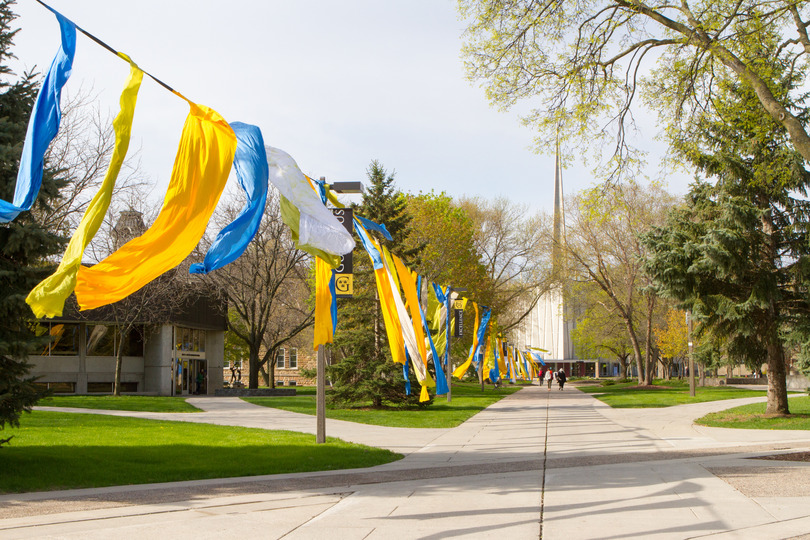History of Christ Chapel

Christ Chapel was dedicated on January 7, 1962, under the presidency of Edgar M. Carlson. It is located in the center of campus, as a symbol of the central place of faith at this church-affiliated college. Glowing from within at night, reflecting the light of the sun in the morning, it acts as a meeting place for the Gustavus community and extended family. Its walls, shaped like spires and shafts, remind us of the upward movement of prayer and the descending movement of revelation. The large windows allow light from within to shine out onto the life outside and the light from the world to enter into the intimacy of worship. Christ Chapel is a place where we learn to listen to other voices - to one another and to God.
The ground breaking for Christ Chapel was held on March 2, 1959. Clement Attlee, former Prime Minister of Great Britain was among other leaders of the Church and State gathered for the event. Construction was completed in the fall of 1961, and the first service held was the opening convocation of Gustavus' one hundredth academic year on September 10, 1961.
The plans for the Chapel were prepared by the architectural firm of Setter, Leach & Lindstrom of Minneapolis. Harry Gerrish was the designer, the George E. Carlstrom Construction Company of Mankato was the general contractor, and Harold Rhykus was the construction superintendent.
The cross at the tip of Christ Chapel's spire is 187 feet above ground level. Over 350 tons of steel were used to erect the building. The walls were formed using 88 pre-cast triangular concrete panels, each weighing nine tons, finished with quartz aggregate on the outside and plaster on the inside. Each panel is 50 feet high, and each exterior wall measures 112 feet wide. There is room enough for 1500 people inside the Chapel — 1200 on the main floor and 300 in the balcony.
The lower portions of the stained glass windows, which separate the giant concrete panels and run the full height of the building, contain contemporary forms of historic symbols: fish, anchors, flames, stars, doves, uniting chains, ships, sacramental cups and wafers, trumpets, serpents and cups of incense. When the sun shines through them, they cast colorful patterns along the walls and throughout the building.
Each of the four entrances to the Chapel are graced with bronze sculptures and friezes by Paul T. Granlund. The four narthexes honor four Gustavus presidents: Eric Norelius, founder of the College; Andrew Jackson, 1863-1876; P. A. Mattson, 1904-1911; and O. J. Johnson, 1913-1942.
Disaster Response
In the spring of 1998, St. Peter suffered a devastating tornado that caused massive destruction on campus and in the community. Many people lost their homes. Most campus buildings were relocated for the rest of that spring. Several buildings on campus had to be torn down or removed.
Critical in the recovery of the community was Lutheran Disaster Response. Workers for this effort stayed in the St. Peter Community for more than a year after the event. They assisted in helping people work with insurance companies or FEMA, and also helped to secure clothes, food, and appliances. They hosted groups for people to respond to the grief and loss. They also assisted in youth programming and responded to needs in the schools.
In addition, alumni of the college and people affiliated with churches helped with the rebuilding effort.
Organ and Other Instruments

The organ in Christ Chapel was originally built by Hillgreen-Lane at the time the Chapel was built. It has been significantly altered in the last 30 years. These renovations, carried out by David Engen and more recently by the Hendrickson Organ Company of St. Peter, include a new console with solid state combination and relay, moving several ranks of pipes from an antiphonal position in the basement into the main organ above the balcony, restructuring the Swell mixture, and extensive repairs following the tornado of 1998. It currently contains 55 speaking ranks of pipes, played from a four-manual console, and has a preparation on the new Great chest for a mounted Kornet V stop.
The Chapel also houses a small portative organ of three stops on one manual which is used for accompanying and especially for continuo playing in Baroque compositions.
A Steinway B (7') piano, in addition to the four-octave set of Schulmerich handbells, rounds out the primary musical instruments in Christ Chapel.
For photos and more information about the organs at Gustavus, see the following website: http://gustavus.edu/~dfienen/Organ/Organs.html